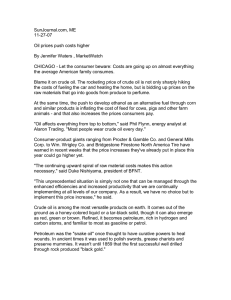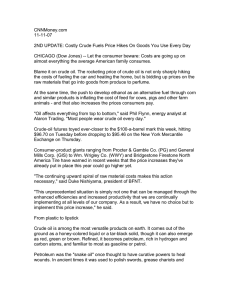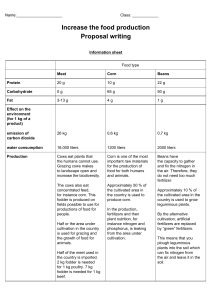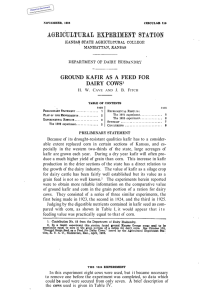Associated Press 12-02-07
advertisement
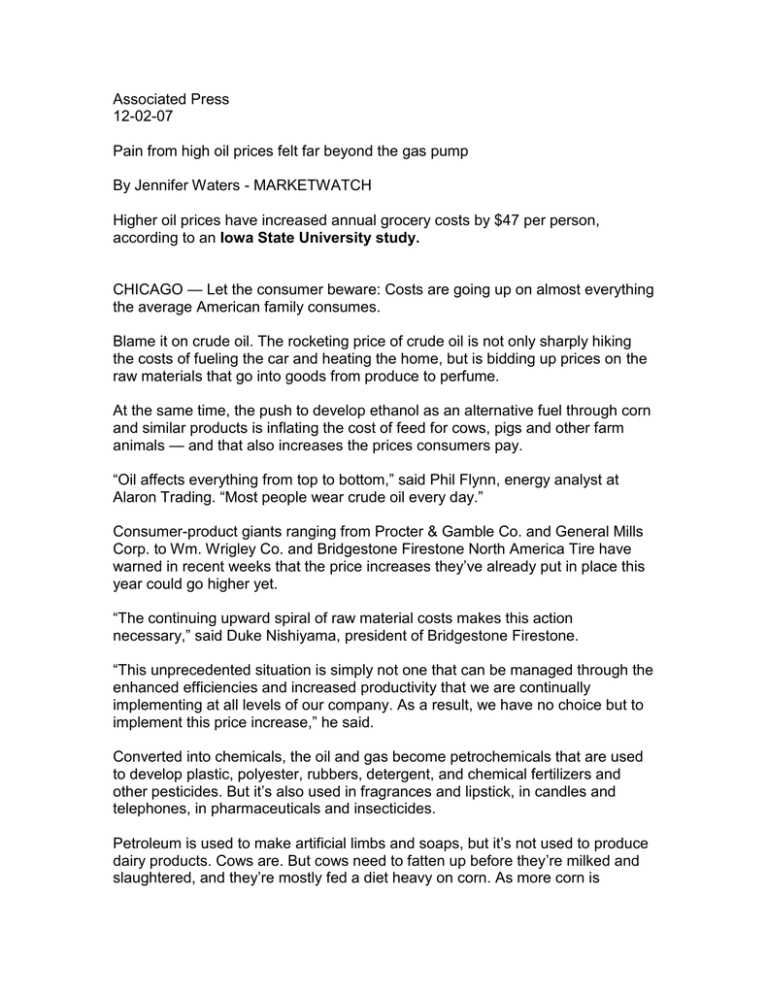
Associated Press 12-02-07 Pain from high oil prices felt far beyond the gas pump By Jennifer Waters - MARKETWATCH Higher oil prices have increased annual grocery costs by $47 per person, according to an Iowa State University study. CHICAGO — Let the consumer beware: Costs are going up on almost everything the average American family consumes. Blame it on crude oil. The rocketing price of crude oil is not only sharply hiking the costs of fueling the car and heating the home, but is bidding up prices on the raw materials that go into goods from produce to perfume. At the same time, the push to develop ethanol as an alternative fuel through corn and similar products is inflating the cost of feed for cows, pigs and other farm animals — and that also increases the prices consumers pay. “Oil affects everything from top to bottom,” said Phil Flynn, energy analyst at Alaron Trading. “Most people wear crude oil every day.” Consumer-product giants ranging from Procter & Gamble Co. and General Mills Corp. to Wm. Wrigley Co. and Bridgestone Firestone North America Tire have warned in recent weeks that the price increases they’ve already put in place this year could go higher yet. “The continuing upward spiral of raw material costs makes this action necessary,” said Duke Nishiyama, president of Bridgestone Firestone. “This unprecedented situation is simply not one that can be managed through the enhanced efficiencies and increased productivity that we are continually implementing at all levels of our company. As a result, we have no choice but to implement this price increase,” he said. Converted into chemicals, the oil and gas become petrochemicals that are used to develop plastic, polyester, rubbers, detergent, and chemical fertilizers and other pesticides. But it’s also used in fragrances and lipstick, in candles and telephones, in pharmaceuticals and insecticides. Petroleum is used to make artificial limbs and soaps, but it’s not used to produce dairy products. Cows are. But cows need to fatten up before they’re milked and slaughtered, and they’re mostly fed a diet heavy on corn. As more corn is directed to energy production, the price for corn has risen and dairy farmers have passed those costs up the food chain. Those higher feed costs alone have infused an extra $47 a year per person into grocery bills, according to an Iowa State University study in May. And don’t forget: Farmers sow crops with tractors and use trucks to haul goods, all of which are fueled by diesel. Those higher transportation costs also get pushed up the food chain. Consumers at the supermarket check-out counter see that they’re paying sometimes record- high prices for milk, cheese and yogurt at the same time that the costs of Tide, Pampers, Ivory soap, M&Ms and Cheerios are creeping up. Consider these recent price hikes: Wrigley — traditionally conservative on pricing — raised prices 10 percent in the second and third quarters on its popular gums and candies. Hershey Co., whose Chief Operating Officer Dave West was one of the few consumerproduct executives to crow that “consumer spending has been up this year and it’s going to be up again next year,” raised prices by about a nickel a candy bar in April. On an earnings call in October, Hershey said it may very well jack prices again in January when there’s a “better view of the commodities situation.” Kraft Foods Chief Executive Irene Rosenfeld told investors that she’s had to raise prices to cover what food companies call “input costs.” Those are the raw materials used for food as well as resins for containers. Wax, for example, is used in packaging frozen foods. Procter & Gamble lifted its prices on Folgers Coffee blends by 8 percent, and by 9 percent on fabric softeners such as the Downy brand. Chief Financial Officer Clayton Daley has said more price hikes are coming, including a 5 percent to 12 percent increase on Olay and Ivory personal cleansing products in January; a 5.5 percent rise on Bounty and Charmin paper products in February; and increases of 5 percent to 9 percent on Pampers disposable diapers and 3 percent to 5 percent on Gillette blades and razors, also in February. “They are not sticker-shock increases,” he said on an earnings call. “Consumers have seen much larger increases in other things they buy than what they are buying from us.” General Mills has taken two tracks. One is to raise prices on products like Yoplait and Green Giant vegetables. The other involves a combination of shrinking the size of cereal boxes of Lucky Charms, Wheaties and other Big G brands while increasing the price for each ounce. As a result, shoppers saw the price per box drop but they got fewer bowls of cereal. In September, Chief Executive Steve Sanger said he’s not afraid to push the pencil again. “We are actively monitoring the need to pass along additional input cost pressures as they arise,” he told investors on an earnings call. Though raising prices can turn off customers and push them away from even favorite items, company executives aren’t afraid of a consumer backlash. “There is not going to be much customer resistance because they are seeing the same energy and commodity cost increases,” P&G Chief Executive A.G. Lafley told investors. “We’re not talking about high out-of-pocket prices for consumers here, and we’re talking about staples,” he said. Yet, a dime here, a dollar there and it all adds up to more pressure on consumer spending.
